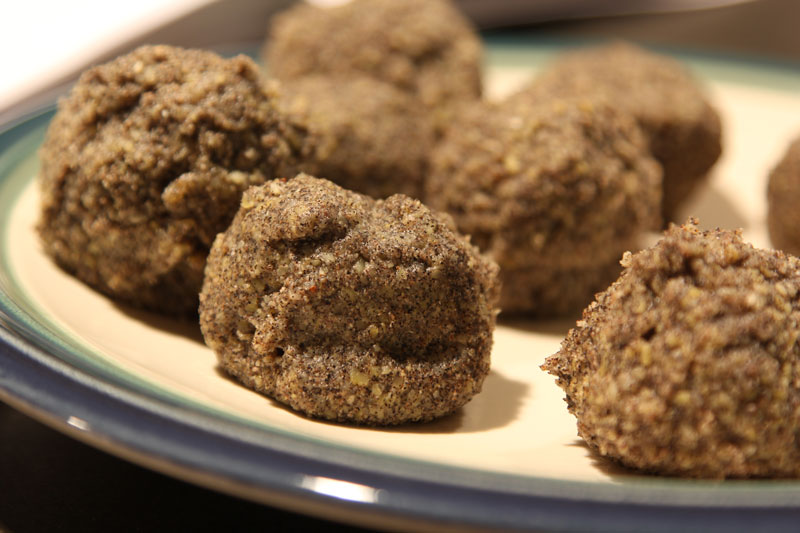
I’d been eating a lot of quinoa while staring longingly at the seeds of its relative, the ubiquitous weed, goosefoot. In fact I kept a jar of the black seeds in my pantry for more than two years before attempting to eat them. Truth be told, I was stumped by them.
I eat goosefoot greens all the time when they are in season. Nicknamed “wild spinach,” the plant is related to both spinach and beets. Common species in Colorado include Chenopodium album, also called “lamb’s quarters,” C. berlandieri, and C. fremontii.
As a group they are weedy, herbaceous plants with leaves ranging from goosefoot-shaped to narrow, often with a whitish, mealy coating. Stems often have red stripes, and the flowers are green clusters of tiny, mealy balls.
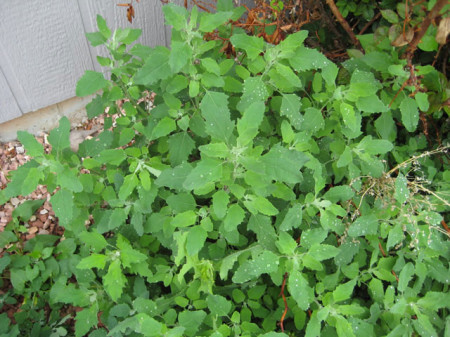
Many of the edible goosefoots I find here at 10,000 feet in the Colorado high country are tiny—less than a foot or two tall, with the biggest leaves the size of an elongated quarter—compared to specimens growing to chest height just a few thousand feet lower. Still, this hasn’t kept me from stripping leaves and flower clusters from the disturbed-area-loving weed and adding them to salads or pans of sautéed greens.
Wash Your Mouth Out with Wild Soap
When the season for greens ends, however, goosefoots’ inconspicuous flowers go to seed. After the plants dry and turn brown in late summer and fall, the fully developed seeds can be stripped into a collecting container along with the dry chaff. Rubbing and winnowing reveals the black seeds.
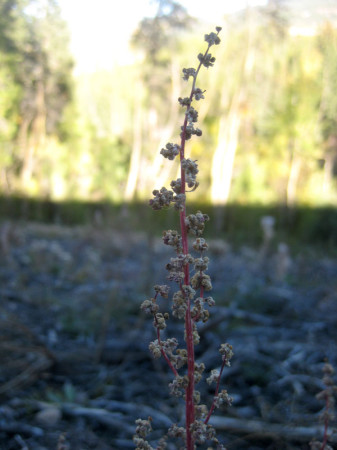
To me, these seeds look delicious—but of course, looks can be deceiving. Indeed, although this quality may vary by species, they are often quite bitter.
John Kallas writes that “the use of these seed capsules or just the seeds as a cooked porridge is complicated by bitterness” which “makes the seed capsules unpalatable and somewhat toxic in large amounts” (Edible Wild Plants, 2010). This bitterness—at least in cultivated quinoa (Chenopodium quinoa) and the wild goosefoot Chenopodium berlandieri—is caused by saponins, he explains.
Saponins are glycoside poisons found in many plants, including common edibles like beans, tomatoes, and spinach. They are used commercially as foaming agents, and if you run water into a bowl of something with a high saponin content like buffaloberries (Sheperdia canadensis) you’ll see why—the water foams up like soap. Similarly, when I run water into a bowl of goosefoot seeds, the water foams up as if I had added dish soap to the bowl.
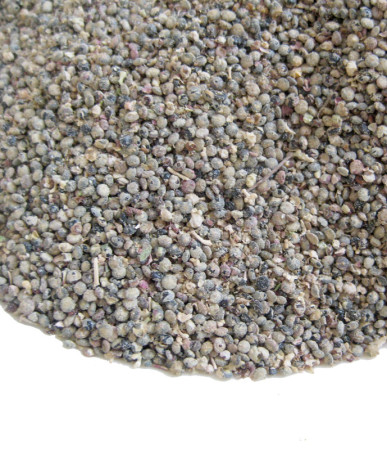
Dietary saponins are not easily absorbed by the digestive system, so upon consumption much of what is eaten passes through. They may have health benefits in small doses—for stimulating digestion and cleansing intestinal walls (Elpel, 2013).
“Saponins may be interesting as potential insecticides, antibiotics, and fungicides, and to the pharmaceutical industry as a mediator of intestinal permeability, which could aid the absorption of specific drugs, and for reducing the level of cholesterol,” writes Sven-Erik Jacobsen (2003).
However, to reduce bitterness and toxicity, most of the saponins should be removed from quinoa and goosefoot seeds prior to eating.
The Blister Method
Kallas includes an interesting account of Bolivian quinoa processing in his book (2010), which involves women toasting the seeds on a metal tray over the fire to loosen the saponin layer before tipping the hot seeds into a stone basin to tread upon with bare feet. This turns the coat to a dust that can be winnowed away. The seeds are later rinsed in several changes of water and set to dry.
Much as I liked the idea of dancing on hot goosefoot seeds in my bare feet, I chose to go with the approach recommended by Green Deane and give the seeds a good overnight soak, followed by a rinse. But first, I had a large batch of dried seeds to rub and winnow.
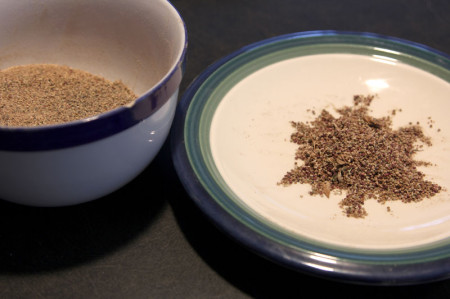
I sat on the couch for a couple hours painstakingly rubbing chaff from seeds, and the dry seeds again for extra measure, between my fingertips. This hurt my fingers a little and I later suffered dry, cracked skin on my fingertips. I also tried rubbing them in a rubber garlic-peeling tube, but they kept flying out—so maybe two flat layers of rubber would work better.
Then I blow-winnowed the stuff on the porch, taking care not to exhale with too much strength lest I lose the light seeds in the breeze. After that I soaked them for 24 hours, changed the water, and rubbed them, underwater in the same bowl, one more time again. Little clear bits floated off, perhaps the saponin-containing coats. These clear bits I swished away and decanted, leaving behind a pretty bowl of black seeds that nonetheless turned a splotchy gray-white after they dried.
Sprouts That Taste Like Beets
I set a small batch of seeds to sprout in a makeshift seed-sprouter made with a layer of seeds at the base of glass jars topped with swatches of a cut cotton T-shirt secured with a rubber band. Then I poured water into each, through the T-shirt, swishing it around and turning it upside down to let the water drain out (pinching out the suction as needed so they would drain thoroughly) and repeating several times a day until tiny sprouts grew. Compared with the dock seeds that I was also sprouting at the time, the lamb’s quarters seeds seemed to sprout in an instant.
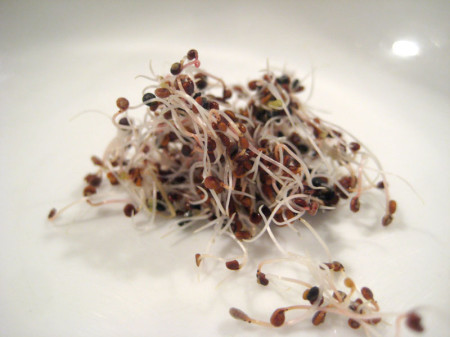
This surprised me, as a friend on FB recently told me of her difficulties sprouting lamb’s quarters. “After three years of paltry little failures, my garden last summer was bursting with the stuff,” she wrote. “Somehow the seeds waited till they survived my handling, the compost, the tilling; then they burst forth to sing their song!”
This too may have to do with the saponins, which I had endeavored to eliminate by rubbing, soaking, and rubbing again under water before germinating. Studies on alfalfa, desert saltbush, and other plants have found saponins to function as growth inhibitors, and extracts of saponins from certain plants have been studied for use as growth inhibitors on other weedy plants.
Whether saponins or other substances, many seeds contain growth inhibitors that help plants maintain dormancy until conditions for germination are ideal. Hence a recommended practice for sprouting seeds is to soak them first.
“Dry seeds are dormant,” write the Sprout People, where I gleaned the basics on sprouting edible seeds. “Soaking a seed ends its dormancy and begins a new life.” They recommend soaking all seeds prior to sprouting—some for as many as 8-12 hours and less for others, depending on the species. Then the seeds need to be rinsed and drained well, several times a day, until they sprout and grow to the desired length.
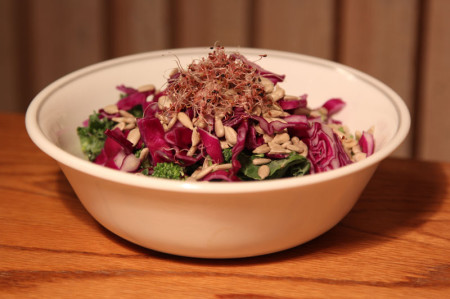
Some seeds, which sprout in nature after an overwintering period, also sprout better after weeks or months in the freezer.
The day I saw the first thin sprouts protruding from the tiny black seeds in my jar it was difficult to contain my excitement. “It’s like magic!” I exclaimed gleefully to a sleep-groggy Gregg, shoving the glass jar in his face the moment he awoke.
After that I continued the process—rinse, drain, watch—and in a couple days the white sprouts turned pink-purple. I served them atop a salad and they made for a nice, flavorful accent that Gregg described as tasting “like beets.”
“Wait, I thought you didn’t like beets,” I accused.
“These are really good,” he replied, and then as I studied his face for a clue to the real answer: “Don’t try to read into what I say.”
Sprouted Flour
I did not intend to sprout all the goosefoot seeds, so I laid the rest of the soaked seeds in a glass baking dish to dry out. But the seeds went ahead and sprouted of their own accord anyway, and the next morning I awoke to find the start of fine, white hairs protruding from many of them.
This turned out to be a boon, as sprouted flour is said to have health benefits over non-sprouted flour. I set the batch over the pilot light on our fake fireplace to fully dry out, and then ground it into a fine, flavorful, protein-rich flour using the coffee grinder.
I wanted to make something special with the goosefoot seed flour, so I then spent a couple mouthwatering hours going through my stack of wild edible books and perusing online accounts for ideas.
“I cook lamb’s quarter seeds in with any grain that I make, such as brown rice, kasha, even quinoa,” writes Susun Weed (Wise Woman Herbal Ezine, September 2009). “I stir lamb’s quarter seeds (and nettle seeds and plantain seeds) into my morning oatmeal when I put it up to boil. I sprinkle lamb’s quarter seeds to pancakes and muffins and cornbread. I add lamb’s quarter seeds to soups, sautéing them with the onion at the beginning of the soup making. I throw lamb’s quarter seeds into my tomato sauce, where they add so much flavor and protein that some people swear I’ve used meat in my sauce.”
Accounts of ethnobotanical uses of Chenopodium album seeds, compiled in Daniel Moerman’s database at the University of Michigan-Dearborn (herb.umd.umich.edu), are many. Seeds have been ground by Hopi people to make mush (Vestal, 1940), and Navajo “like corn” (Elmore, 1944), and Paiute by parching, grinding, and eating as meal (Kelly, 1932).
Niethammer includes a number of interesting recipes that call for lamb’s quarter seeds in her cookbook, American Indian Cooking, a compilation of original and modified recipes informed by native peoples in the Southwest (1974), including Lamb’s-Quarter Seed Bread, Zuni Steamed Bread, and Navajo Griddle Cakes.
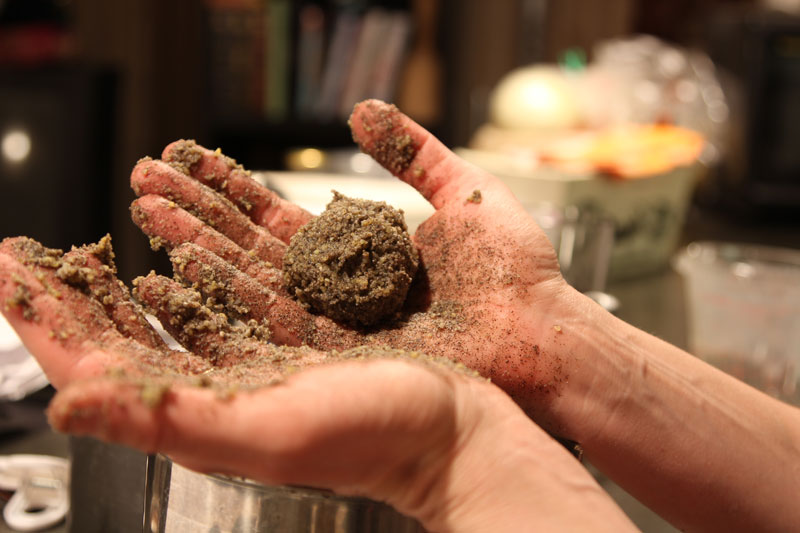
I decided to try the Zuni Steamed Bread. To make it, you cook a covered pot of cornmeal, water, and salt until thick, then remove that from the heat, add the lamb’s quarter seed flour, form the mixture into balls, and “steam the dumplings until done.” I ran into a few complications, the biggest of which was the extreme stickiness of the dough. So I added extra goosefoot seed flour and also let it cool for a bit before making the balls, and it did consolidate somewhat. The balls were nonetheless tricky to form, but again, they cohered more the longer I let them sit. Then they softened again during the steaming process.
I served them in a stew of beef, porcini, potatoes, and wild red wine that Gregg made in the crock pot the day before. I absolutely loved them—the texture, the distinctive goosefoot seed flavor, the nostalgia for a land and place I do not know. They made a perfect accompaniment to the stew.
“What do you think?” I asked Gregg.
“They’re good,” he replied. “They taste like beets.”
“But I thought you didn’t like beets,” I reiterated.
“I do now,” he said, shooting me a warning glance.
My experiments with goosefoot seeds went remarkably well. Now it is simply a matter of finding enough to satisfy this growing wild appetite, and wrangling my better half into helping rub and winnow them.
Updated 2.23.21

So how did they taste? We’re the dumplings gritty or same as regular dumplings? Just curious as I love dumplings. -G
Hi Greg, they were not gritty. I suppose they could be if you forage the seeds in an area where wind blows sand. But mine were very good, not gritty, tasting a bit of beets.
Wow, so inspiring! I’ve collected some goosefoot seeds myself. I soaked them overnight and they were not the slightest bitter. Have some seeds left and wondered if anybody has sprouted them – I’m happy to have found out you’ve done this with good results. I’ll try growing mine as microgreens as there’s so much chaff still left among the seeds.
Thank you for this article. I love lamb’s quarter, but I never think of it as being Chenopodium or goosefoot; although I immediately think of Chenopodium as being goosefoot. I haven’t had any in a long time, and never thought of eating the seeds. Have you tried decanting the Saponins and drying to use as, lol, soap? Might consider decanting the chaff to use as a scrub. Who knows?
I’ve been a foraging enthusiast for 50 yrs. Even took several really good Botany classes in college. Until recently, it’s been hard to find info. Glad to have stumbled into your website.
Welcome! The closest I’ve gotten to using saponins as soap was to save the goosefoot seed wash-water and use that in the shower. I guess it worked okay. Please let me know if you try it!
I was reading that the sprouting process pops off the chaff and you can rinse it away instead of rubbing and winnowing first…
Can You use it as soap?
What’s the medicinal value?
Does it improve The skin?
Just wondering?
Thanks for The awesome information.
Happy Blessed everyday from the North Georgia Mountains .
Interesting! Thank you for sharing. I will have to look into that.
Hi Barbara,
Supposedly yes you can use it as soap. I have tried halfheartedly, using the rinse water as a liquid soap. I don’t know if it improves the skin.
Lamb’s quarters is a famously healthy food, although I don’t have much information specifically on the seeds. They do contain some antinutrients, which we reduce via processing. I can share some data about the greens: The USDA found the raw greens of C. album to have more calories, fiber, protein, calcium, vitamin A, copper, and several B vitamins than cultivated spinach, as well as extremely high vitamin C, a 100-gram serving containing 89% of the recommended daily intake. Its high quality protein is rich in essential amino acids the body cannot manufacture (and protein levels are higher in the seeds than the greens); and high levels of iron, potassium, zinc, and magnesium make it a good source of minerals (Poonia and Upadhayay, 2015). A number of recent studies support traditional uses of C. album as an antimicrobial, anti-parasitic, and antifungal agent, and it is also being investigated for its antioxidant, free-radical scavenging, and cancer growth-slowing properties (ibid.).
Thank you for the kind words:)
Wow, thank you so so much for a very informative article which covered a lot of bases. A few years ago, when lambsquarter first took over my garden patch, I looked for ways to use the seeds. Thanks to you, I am now trying to sprout some 2 year old seeds. Also very interested in using it as flour, and grinding the seeds. All of this and more are mentioned in your article. I’m inspired to reboot. Wow. Good day!
We ground the cleaned seeds so it’s too late to sprout them. Can we still use the flour?
Definitely:)
Hi Corrina, I have not gotten that to work. I usually work with the lamb’s quarters species C. berlandieri. There are a lot of saponins in the seed coat, evidenced by the suds when I rub and rinse the seeds. Saponins are germination inhibitors. So, if I don’t rub, winnow, and then rub/rinse the seeds well enough for the soap to go away, they just do not sprout. However, this may be different in other species/varieties with less saponins. Let us know if you try it!